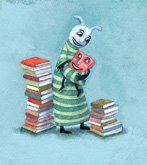
Physics was never my best subject. I switched from a social sciences major to humanities just before the critical point where I was going to flunk. Humanities majors could get by with only biology.
Living in the mountains, we do not receive radio, which made for boring car rides until we discovered audiobooks. Currently, we are listening to Walter Isaacson's
Einstein: His Life and Universe. (Sometimes my husband gets to choose the book.) I like and understand the simple bits:
Life. Nick likes and understands
Universe. Isaacson's book is so well written, though, I almost get parts of the science, particularly if I stop and let Nick re-explain them to me half a dozen times. So, I thought I'd take another crack at
The Time and Space of Uncle Albert. Which I flunked the first time
.Uncle Albert, who may or may not live in New Jersey, has a niece, Gedanken. Gedanken, who may or may not be around 11 or 12, has to do a science project for school. The projects her classmates have chosen strike her as really boring: dinosaurs, volcanoes. . .you know, the usual. Her teacher's suggestion, Energy in the Home -- "double-glazing, electric toothbrushes and that sort of thing," strikes her as even more mind-numbing.
Gedanken and Uncle Albert are discussing her problem one evening, sitting and watching the stars, when Uncle Albert recollects the wonder he felt as boy upon discovering how far away the stars are: so far their light takes years and years to get here, even though light travels at 300,000 kilometres a second. That's 186,000 miles a second. Or, to put it another way: five times round the Earth in the time it takes to say "rice pudding."
Lately his interest in light has been rekindled. Maybe Gedanken could help him with his research and write about it for her project. So begins Gedanken's adventures. Travelling in a space ship that appears in a thought bubble above Uncle Albert's head, and with the help of Dick, the computer, Gedanken discovers slow-motion time, squashed-up time, heavy energy and how to live forever.
And I almost did, too. (So that I don't spoil the fun, so you might want to look up
gedanken experiment in a big dictionary.) By the way, this is a kid's book.


























